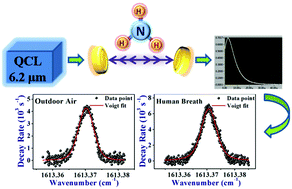High-resolution spectral analysis of ammonia near 6.2 μm using a cw EC-QCL coupled with cavity ring-down spectroscopy
Abstract
We report on the development of a mid-infrared cavity ring-down spectrometer (CRDS) coupled with a continuous wave (cw) external cavity quantum cascade laser (EC-QCL), operating between 6.0 μm and 6.3 μm, for high-resolution spectroscopic studies of ammonia (NH3) which served as a bench-mark molecule in this spectral region. We characterized the EC-QCL based CRDS system in detail and achieved a noise-equivalent absorption (NEA) coefficient of 2.11 × 10−9 cm−1 Hz−1/2 for a 100 Hz data acquisition rate. We thereafter exploited the system for high-resolution spectroscopic analysis of interference-free 10 transition lines of the ν4 fundamental vibrational band of NH3 centred at ∼6.2 μm. We probed the strongest interference-free absorption line RQ(4,3) of ν4, centred at 1613.370 cm−1 for highly-sensitive trace detection of NH3 and subsequently achieved a minimum detection sensitivity (1σ) of 2.78 × 109 molecules per cm3 which translated into the detection limit of 740 parts-per-trillion by volume (pptv/10−12) at a pressure of 115 Torr for an integration time of ∼167 seconds. To demonstrate the efficacy of the present system in real-life applications, we finally measured the mixing ratios of NH3 present in ambient air and human exhaled breath with high sensitivity and molecular specificity.



 Please wait while we load your content...
Please wait while we load your content...